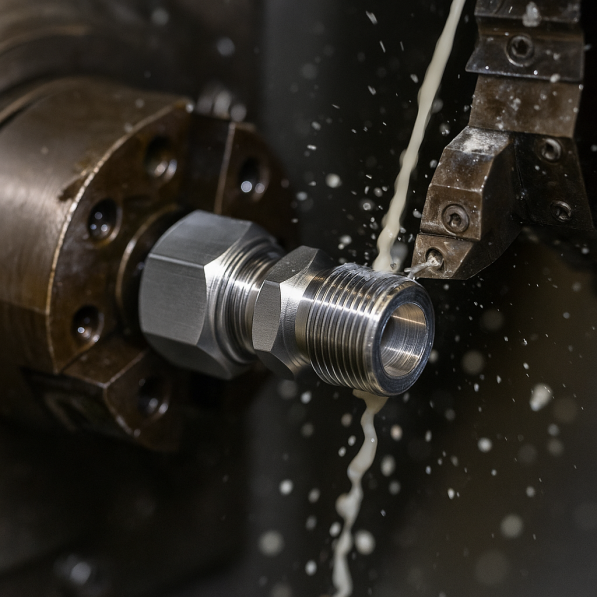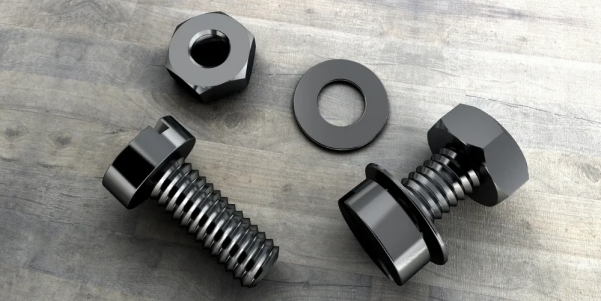12L14 Steel Guide: Properties, Machinability, and Uses
 Nov 04,2025
Nov 04,2025

12L14 steel is very versatile and has become important material in different industries like automotive, manufacturing, construction and electronics. AISI 12L14 steel has excellent machinability and mechanical properties. This article will explore its properties in detail, application and pros and cons of using this in different industries. So, let’s get started!

What Is 12L14 Steel?
12L14 is a low-carbon, leaded free-machining steel. It is mostly used in high speed and high-volume production parts like bolts and fasteners due to its ultra-high machinability.
12L14 Steel Explained
12L14 steel high machinability is due to presence of lead and other elements like sulfur (S). S increases ductility but lowers its strength compared to other steels. And that is why it is not recommended for welding and heat treatment but for case hardening.
Mild Steel Grade Family
12L14 free machining steel belongs to mild steel family. Mild steels usually have high ductility and toughness, but their machinability varied from grade to grade. 12L14 steel is specifically alloyed with lead and sulfur to make it highly machinable to use in producing parts like shafts, bolts and fasteners that require cutting.

Chemical Composition and Standards
Chemical composition of 12L14 is as:
|
Elements |
Percentage |
|
Carbon |
Less than 0.15% |
|
Manganese |
0.85-1.15% |
|
Phosphorus |
0.04-0.09% |
|
Sulfur |
0.26-0.35% |
|
Lead |
0.15-0.35% |
Nominal Chemistry (C, Mn, P, S, Pb)
Carbon in 12L14 is low due to mild steel and making it machinable but reduces its strength. Manganese increases strength and hardness, and lead, sulfur and phosphorus further enhance its free-machining properties by creating small and brittle chips that are easy to break.
Common Specifications and Designations
The most common designation for lead free machining steel is AISI/SAE12L14. L denotes the presence of lead. Other specifications and designations are:
|
Designation |
Explanation |
|
UNS G12144 |
United States National designation |
|
ASTM A108 |
cold-finished carbon steel bars |
|
EN 11SMnPb |
European designation for a similar free-cutting, leaded steel |
Other Common Free-Cutting Leaded Steel Equivalents
Common free-cutting leaded steel equivalents are ASTM 12L14 and JIS SUM31, with ISO and EN grades like 11SMnPb28 and 11SMnPb37. Other grades have lead-free options like 11SMn30 with good machinability, and more specialized grades like11SMnPb37+Te+Bi for extremely high machinability.
Mechanical and Physical Properties
12L14 steel has its own unique physical and mechanical properties that can vary depending on the conditions like material is cold drawn or turned and polished.
12L14 Mechanical Properties
The 12l14 steel properties are as:
1.Tensile Strength
The tensile strength of 12L14 steel is 440-760 MPa (64-110 ksi)
2.Yield Strength
The yield strength of12L14 steel is 260-590 MPa (38-86 ksi)
3.Hardness (HB/HRC)
Brinell hardness of the material ranges between 140 and 225 (about 85 HRB)
4.Modulus of Elasticity
The modulus of elasticity of approximately 190-210 GPa (27,500-30,500 ksi)
|
Properties |
Values |
|
Tensile Strength |
440-760 MPa |
|
Yield Strength |
260-590 MPa |
|
Hardness |
140-225 HB |
|
Modulus of Elasticity |
190-210 GPa |
|
Elongation |
10-20% (in 2 inches) |
|
Machinability |
160% (high) |
12L14 Physical Properties
The 12l14 steel properties are as:
1.Density
Density is the measure of mass per unit volume and 12L14 has density
2.Thermal Properties
Thermal conductivity of the steel is 51.9Wm/K and thermal expansion is
3.Electrical Resistivity
Steel alloys normally have higher electrical resistivity than pure metals. This measures the resistance of flow of electric current.
4.Magnetic Permeability
It is high for 12L4 free machining steel because it is a ferromagnetic material. Magnetic permeability supports the formation of a magnetic field
5.Melting Point
Alloys have a melting range and 12L14 steel melts between 1,450−1,500◦C.
Machinability: Why 12L14 Is So Fast
12L14 carbon steel is so fast because of being free-machining steel. This means it has elements like sulfur and lead that break up into small chips and lubricate the cut. It increases the machining speeds and speeds up the metal removal rates.

What Is Free-Machining Steel?
The free-machining steel is any steel that can be easily cut or drilled. It overall reduces the machining cost and lead time. Small and brittle chops are produced from machining that do not wrap around the cutting tool. Machineries are then automated to run longer with less human intervention. Presence of lead and sulfur helps the 12L14 steel properties to obtain this level of high speed machining.
What Drives Machinability
There are few reasons that drive this level of machinability in 12L14 carbon steel. some of them are as:
1.Material Chemistry
Main reason for the performance of 12L14 steel is the addition of allying elements like lead and high amount of sulfur. Sulfur in present as manganese sulfide (MnS) inclusion which breaks the chips into smaller and manageable prices. And lead acts as an internal lubricant. It reduces friction and heat buildup at the cutting tool interface and increases speed and tool life.
2.Microstructure
Presence of non-metallic inclusions MnS in the microstructure fundamentally changes the cutting behavior. The material shears more easily around these inclusions and instead of making long and stringy chips, it makes smaller and broken chips.
3.Hardness/Work-Hardening
12L14 is relatively soft and has low hardness in its as-supplied condition due to low carbon content. It does not work harden as frequently as other steels and thus requires less cutting force. Low hardness means it is not suitable for high strength or wear resistance required applications but ideal for parts like fasteners and bushings where high precision is required more than strength
4.Bar Condition
Bar conditions mean the state of the material itself like its surface finish and internal stresses. The standard condition for 12L14 is cold drawn, which is also suitable for its deliberated high-speed machining applications. However, some heat treatments can also increase their hardness. But it is less common because it can reduce the benefits of free-machining additives and can make welding more difficult.
Benefits of Using 12L14 Steel
There are many benefits of using 12l14 carbon steel mainly because of its free machining properties. some of them are:
- Exceptional chip breaking:presence of sulfur forms manganese sulfide inclusions that act as stress concentration points. This leads to smaller chips during machining.
- Longer tool life:The inclusions and added lead also act as a lubricant. They reduce the friction and wear on cutting tools.
- High production rates:The combination of better chip formation and low wear increases the cutting speeds and leads to faster production times.
- Lower machining costs:less tool wear and faster cycle times overall reduce the manufacturing costs.
- High-quality surface finish:12L14 carbon steel has a smooth machined surface and it is important for precision components.
CNC Machining 12L14 Steel
The most common CNC Machining methods for 12L14 steel are turning and milling. There are few tips to follow to get optimized machining results which are:

Turning 12L14 Steel
The turning process for 12L14 carbon steel is:
- Machine setup:Secure the stock in the chuck and make it stable and centered.
- Programming:Use G-code to program the tool path, speed, and other parameters.
- Face and turning:start facing and turning operations to get the required dimensions.
- Drilling:drill holes in the workpiece if needed and use appropriate speeds around 255 m/min.
- Finishing :follow the same steps to finish the opposite side of the part.
Tips for Turning 12L14 Steel
Follow these tips to get optimized results for turning
- Speed:use high cutting speed for 12L14 steel up to 855 m/min.
- Tools:use sharp tools to get good finish and extend tool life.
- Use lead content:lead in 12L14 is a lubricant and reduces friction and increases tool life.
- Chips management:12L14 has short and easily manageable chips and they keep the operation smooth.
- Optimization:use techniques like Response Surface Methodology (RSM) to optimize process parameters for better surface roughness and quality.
Milling 12L14 Steel
The procedure for milling the steel is:
- Secure the alloy:Mount the part in the chuck or fixture. If using lathe, use a four-jaw chuck and rings for alignment.
- Programming:Program the work offset for the machine and part.
- Milling:by using the programmed G-code, mill the part and carefully analyze the depth of cut and feed rate.
- Chips management:clear the chips from cutting area, especially when milling on a lathe.
- Measurement:Measure the part to meet the required dimensions and re-position for second-side operation.
Tips for Milling 12L14 Steel
Follow these tips to get optimized results for milling
- cuts:start with shallow cuts to avoid overloading the machine or breaking the tool like 0.02in
- Speed:use high cutting speeds for milling around 395 to 530 m/min.
- Tools:Use carbide endmills with a high-quality coating for longer tool life and better performance.
- chip evacuation:clear the path for the chip’s evacuation from the cutting area to prevent them causing tool breakage or rec-cutting them with workpiece.
- Speed for high-speed steel tools:High-speed steel tools should not be run at high RPMs to avoid over-heating.
Is 12L14 Hard to Weld?
Yes, 12L14 steel is difficult to weld. It is due to being a free-machining steel, unlike ASTM A36 and other low-carbon steels that can be welded easily. The major challenges are its ability to form undercuts and the risk of cracking due to its composition.
Why 12L14 Is Hard to Weld?
There are a few reasons for 12L14 poor welding. It contains high sulfur content which breaks the chips during machining and weakens the weld. High sulfur and lead content makes it prone to cracking. Other reason is It also has tendency to create undercuts, grooves or notches around the weld toe during TIG welding
Welding and Challenges
Major challenges are poor weldability due to its unique composition unlike other low carbon-steels. It also has high risks of defects and stress that are unreliable for anything other than low-stress applications.
Safer Welding Materials Choices
Safer welding materials are ASTM A36 which has good general fabrication and weldability. Low-carbon alloys other than 12L14 which have less sulfur and lead have higher weldability.
12L14 vs 1018 vs 1215: Side-by-Side Comparison
These are all common free machining steels. A brief comparison of all these based on common properties are as:
Mechanical Strength
12:14 has lowest mechanical strength among all due to low carbon content. 1018 has the highest and 1215 has moderate mechanical strength.
Composition and Lead Content
12L14 has lead for lubrication up to 0.35%. 1018 is low carbon steel with no added elements for machinability. 1215 has high sulfur of 0.30% but has no lead.
Practical Machinability
12L14 has the highest machinability. 1018 has the lowest and 1215 has high machinability due to high sulfur content and create brittle chips.
When to Choose 12L14 and When to Choose Alternatives
The selection of these alternatives depends on the requirements and applications of the alloy.
12L14 vs 1045 steel
12L14 is preferred over 1045 steel when excellent machinability is the top priority and for high-volume production run on CNC machines. 1045 has higher strength and hardness than 12L14.
12L14 vs 4140 steel
4140 has higher strength, toughness, and wear resistance than 12L14
Common Applications for 12L14 Steel
12L14 has many applications and some of them are:
High-Volume Turned Parts
12l14 is used in automatic machines to make large quantities of parts with tight tolerances and smooth finishing.
12L14 Screws
12L14 screws are prepared for a wide range of uses ranging from industrial equipment to non-critical fasteners.
12L14 Fittings
12L14 fittings are used commonly in hydraulic, pneumatic, and other fluid systems.
12L14 Bushings
12L14 bushings are used widely due to their excellent high speed machining capabilities.
Hydraulic/Pneumatic Components
12L14 is used in components like fittings, adapters, and piston rods for hydraulic and pneumatic systems.
Custom Machined Steel Parts
12L14 steels serves for different custom components like spindles, couplings, gears, and valve components.
Conclusion
12L14 is a free-machining steel alloy and has excellent machinability due to the presence of lead and manganese sulfides. It also has better wear resistance and surface finish. the tensile strength of steel is around 70,000–80,000 psi with machinability of 160%. It is mostly used for its high speed machining.
And for high-volume production parts like bushings, fittings, and inserts. But it has poor weldability and limited formability.
FAQs
Is 12L14 a mild steel?
It has low carbon content but due to presence of other alloying elements, it is considered as mild steel
What is stronger, brass or mild steel?
Mild steel is stronger than brass because it has higher yield and tensile strength
What is the strongest steel for tools?
High-speed tools like M2 are the strongest steel for tools
Can 12L14 be heat treated for high hardness?
No, it cannot be heat-treated because of its low carbon content and machining additive
 Tel/WeChat:
Tel/WeChat:  Email:
Email: 
 Home
Home
 What Is Spring Steel? -A Guide of Grades, Machining & Design
What Is Spring Steel? -A Guide of Grades, Machining & Design 







